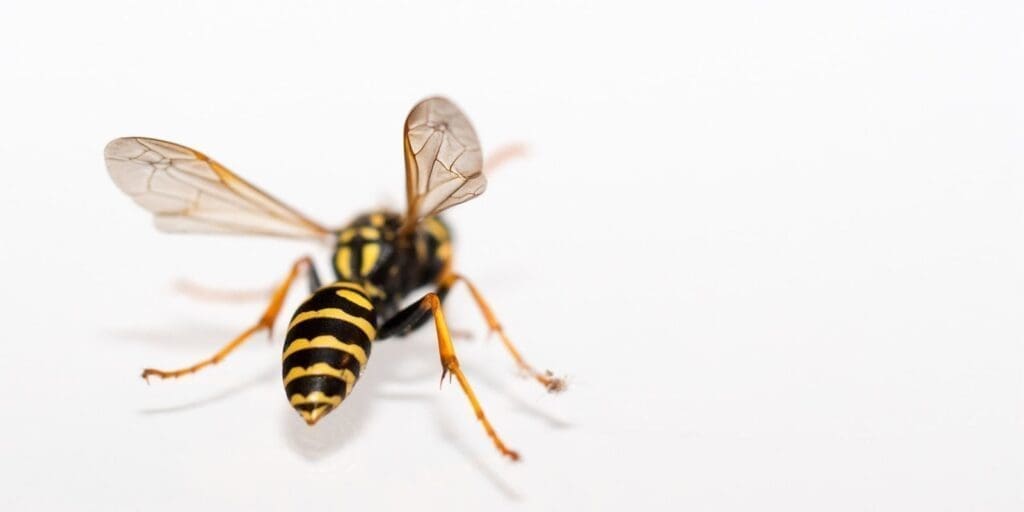
Stinging insects can pose serious threats to your family's safety and comfort, particularly during peak seasons in the Southern US region. From paper wasps to yellowjackets, these unwanted visitors often build nests around homes and can become aggressive when disturbed. Understanding how to identify and control these pests is crucial for maintaining a safe outdoor environment.
You'll be glad to know that there are multiple effective approaches to managing stinging insects, including professional pest control services. Whether you're dealing with established nests or trying to prevent future infestations, it's important to choose methods that balance effectiveness with environmental responsibility. For those who are allergic to insect stings, proper pest management isn't just about convenience—it's essential for health and safety.
The Complete Guide to Stinging Insects
Common Types of Stinging Insects
Stinging insects in residential areas include:
- Bumble bees: large, fuzzy insects nesting in ground cavities
- Paper wasps: slender bodies building open-cell nests under eaves
- Carpenter bees: wood-boring insects creating perfectly round holes
- Yellowjackets: aggressive wasps with yellow and black stripes
- Mud daubers: solitary wasps constructing mud tube nests
- Fire ants: reddish-brown ants forming mounds in lawns
Identification and Behavior
Key characteristics to identify stinging insects:
- Nest appearance and location
- Flight patterns and activity levels
- Body size and coloration
- Seasonal presence
- Defensive behaviors
Signs of Infestation
Monitor these indicators of stinging insect presence:
- Active nests in eaves, trees, shrubs or ground
- Increased insect activity around structures
- Visible swarms near light sources
- Multiple stings reported in an area
- Regular insects entering/exiting specific locations
Prevention Techniques
Implement these preventive measures:
- Seal exterior gaps larger than ¼ inch
- Remove sweet-scented plants near entrances
- Keep outdoor garbage containers sealed
- Maintain screens on windows and vents
- Clear fallen fruit from yard areas
- Pheromone-based traps
- Natural repellents (citronella, eucalyptus)
- Non-toxic deterrent sprays
- Professional pest services
| Treatment Type | Effectiveness | Duration |
|---|---|---|
| Baited Traps | 65-75% | 2-3 weeks |
| Natural Repellents | 40-50% | 1-2 weeks |
| Professional Treatment | 90-95% | 3-6 months |
Understanding Stinging Insect Behavior
Stinging insects exhibit distinct behavioral patterns throughout their lifecycle. These patterns influence their nesting preferences seasonal activities.
Nesting Habits
Stinging insects construct nests in specific locations based on their species:
- Paper wasps build open-cell nests under eaves overhangs porches
- Yellow jackets create enclosed nests in ground cavities wall voids shrubs
- Honey bees establish colonies in hollow trees building structures cavities
- Carpenter bees bore into wood surfaces creating tunnel networks
- Mud daubers form cylindrical mud tubes on vertical surfaces
Each nest serves multiple functions:
- Protection for eggs larvae developing pupae
- Storage space for food resources
- Central location for colony activities foraging
- Shelter from weather predators environmental threats
Seasonal Activity Patterns
Stinging insect activity follows predictable annual cycles:
| Season | Activity Level | Colony Status |
|---|---|---|
| Spring | Moderate | Queen emergence nest building |
| Summer | High | Peak population colony growth |
| Late Summer | Highest | New queens males produced |
| Fall | Declining | Colony dispersal preparation for winter |
| Winter | Minimal | Queens hibernate colonies die off |
- Spring emergence focuses on nest construction food gathering
- Summer activities center on colony expansion brood care
- Late summer brings increased aggression food scavenging
- Fall triggers mating cycles winter preparation strategies
Identifying an Infestation
Stinging insect infestations present clear signs indicating their presence around your property. Recognizing these indicators early enables effective management before colonies grow too large.
Visual Signs to Look For
- Spot consistent insect traffic entering specific locations like wall voids or ground openings
- Notice paper-like nests under eaves soffits or deck railings measuring 6-8 inches in diameter
- Observe multiple insects hovering around outdoor light fixtures or garbage containers
- Find small holes in wooden structures approximately 1⁄2 inch wide with sawdust below
- See increased activity at nest entrances during dawn dusk hours
High-Risk Areas Around Your Property
- Eaves soffits overhangs where paper wasps build exposed nests
- Ground cavities abandoned rodent burrows housing yellow jacket colonies
- Wooden structures including decks fences gazebos attracting carpenter bees
- Landscaping elements like retaining walls mulch beds harboring ground-nesting bees
- Utility entry points vents pipes creating access to wall voids
- Tree branches shrubs extending close to building structures
- Multiple nests appear on your property within a 30-foot radius
- Insects demonstrate aggressive behavior when approaching within 10 feet
- Colonies establish inside wall voids requiring structural access
- Nests measure larger than 8 inches indicating established colonies
- Previous removal attempts failed to eliminate the infestation
- Property contains multiple high-risk areas requiring simultaneous treatment
| Risk Level | Colony Size | Distance to Living Areas | Professional Assessment |
|---|---|---|---|
| Low | Under 100 insects | Over 30 feet | Optional |
| Moderate | 100-500 insects | 15-30 feet | Recommended |
| High | 500+ insects | Under 15 feet | Required |
Common Types of Stinging Insects
Stinging insects comprise various species with distinct characteristics physical features nesting habits. Here's a detailed overview of common stinging insects found in residential areas.
Bumblebees
Bumblebees measure 0.6-1 inch long with plump hairy bodies displaying black yellow orange banding. These social insects nest underground near patios decks or inside soffits creating colonies of 40-200 members. As key pollinators they demonstrate docile behavior stinging only when defending their nest.
Carpenter Bees
Carpenter bees resemble bumblebees but feature shiny hairless abdomens. These solitary insects bore 0.5-inch circular holes in wooden structures creating tunnel networks for egg-laying. They target unpainted wood at least 2 inches thick including decks fences window sills roof eaves.
Honeybees
Honeybees display slightly fuzzy bodies with alternating yellow brown stripes measuring 0.5 inches long. These colonial insects establish hives in tree hollows wall cavities empty containers. Each colony contains 20000-80000 bees maintaining organized social structures focused on honey production pollination. Bees are a protected species, so when you inquire for bee removal services, ensure the company is licensed to take care of your bees.
Baldfaced Hornets
Baldfaced hornets exhibit black white markings measuring 0.75 inches long. These aerial nesters construct large grey paper nests in trees building structures reaching 14 inches diameter. Colonies contain 100-400 members demonstrating aggressive defense behaviors.
European Hornets
European hornets reach 1.5 inches long featuring brown red coloring with yellow abdominal stripes. These nocturnal insects build paper nests in hollow trees building cavities. Colonies grow to 200-400 members showing increased aggression during late summer.
Mud Daubers
Mud daubers appear slender black measuring 1 inch long with thread-like waists. These solitary wasps construct distinctive tube-shaped mud nests on vertical surfaces. They prey on spiders demonstrating non-aggressive behavior toward humans.
Velvet Ants
Velvet ants are wingless wasps covered in dense colored fur measuring 0.5 inches long. These solitary ground-dwelling insects parasitize bee wasp nests. Females deliver extremely painful stings earning them the nickname "cow killers."
Paper Wasp
Paper wasps measure 0.75-1 inch long displaying reddish-brown black coloring with yellow markings. They build open-celled paper nests under eaves overhangs containing 20-30 members. These insects become aggressive when defending nests near human activity.
Yellowjacket
Yellowjackets measure 0.5 inches long featuring distinct black yellow striped patterns. These social insects construct large paper nests underground or within structures housing colonies of 1000-4000 members. Their aggressive behavior peaks during late summer when colonies reach maximum size.
| Insect Type | Colony Size | Nest Location | Aggression Level |
|---|---|---|---|
| Bumblebees | 40-200 | Underground | Low |
| Honeybees | 20000-80000 | Cavities | Low |
| Paper Wasps | 20-30 | Elevated | Moderate |
| Yellowjackets | 1000-4000 | Ground/Structure | High |
| European Hornets | 200-400 | Hollows | High |
Romex Pest Control Professional Safe Removal Methods
Professional pest control technicians implement Integrated Pest Management (IPM) strategies for safe stinging insect removal through a systematic process:
Initial Assessment
- Conduct thorough property inspections to identify pest species
- Document nest locations points of entry
- Evaluate proximity risks to residents pets neighbors
- Assess environmental factors affecting treatment options
Treatment Implementation
- Apply eco-friendly solutions as first-line interventions
- Use EPA-approved low-toxicity products for severe infestations
- Implement containment protocols to prevent pest dispersal
- Coordinate with beekeepers for honeybee colony relocations
Safety Protocols
- Clear treatment areas of people pets before application
- Install protective barriers around treatment zones
- Monitor adjacent areas for unexpected pest movement
- Maintain proper protective equipment during removal
| Safety Measure | Benefit |
|---|---|
| Professional Insurance | Covers treatment-related accidents |
| EPA-Approved Products | Ensures minimal environmental impact |
| Systematic Containment | Prevents pest spread during removal |
| Expert Assessment | Reduces risk of allergic reactions |
- Seal entry points around structures
- Remove remaining nest materials
- Install preventive barriers
- Provide detailed prevention guidelines
Professional pest control services offer comprehensive protection through:
- Licensed technicians with field-tested expertise
- Structured removal protocols for different species
- Insurance coverage for treatment-related incidents
- Systematic follow-up inspections
These methods ensure safe effective removal while protecting property occupants environment. Professionals handle unexpected complications like displaced colonies dispersed nests requiring no additional cost for supplementary treatments.
Prevention Strategies
Effective prevention of stinging insect infestations focuses on modifying your property's conditions to make it less attractive to these pests. These strategies combine habitat modifications with natural deterrents to create an integrated approach to pest management.
Habitat Modification
- Remove fallen fruit debris from yards within 24 hours
- Seal exterior gaps larger than 1/8 inch with appropriate materials (caulk, foam, metal mesh)
- Cover garbage containers with tight-fitting lids
- Install fine mesh screens on vents soffit openings
- Repair damaged wood siding fascia boards eaves
- Fill ground holes cavities with gravel or soil
- Keep mulch 6 inches away from building foundations
- Trim tree branches shrubs 3 feet from structures
- Plant natural repellents: peppermint eucalyptus citronella marigolds
- Hang decoy wasp nests at 20-foot intervals under eaves
- Create vinegar spray solutions with 2 parts water 1 part vinegar
- Place cucumber peels near entry points doors windows
- Maintain cedar mulch beds around property perimeter
- Use essential oil mixtures:
- 10 drops clove oil
- 10 drops geranium oil
- 10 drops lemongrass oil
- 2 cups water
- Position citrus-scented plants near outdoor gathering areas
- Maintain bird feeders 30 feet from structures (birds eat insects)
Health and Safety Considerations
Stinging insects pose significant health risks, particularly for individuals with allergies. Understanding these risks and knowing proper response procedures ensures safety during encounters with these pests.
Allergic Reaction Risks
Allergic reactions to insect stings range from mild local responses to severe systemic reactions. Common symptoms include:
- Swelling beyond the sting site
- Hives or rash across multiple body areas
- Difficulty breathing or wheezing
- Dizziness or rapid pulse
- Nausea or stomach cramps
People with known allergies must:
- Carry injectable epinephrine devices
- Wear medical alert identification
- Consult an allergist-immunologist
- Inform family members about allergy status
Remove the stinger:
- Use a credit card edge or fingernail
- Scrape horizontally across the skin
- Avoid using tweezers which squeeze more venom
Basic treatment steps:
- Clean with soap and water
- Apply cold compress
- Take antihistamines for swelling
- Use pain relievers for discomfort
Emergency situations:
- Call emergency services for severe reactions
- Administer epinephrine if prescribed
- Seek medical attention for multiple stings
- Monitor breathing and consciousness
| Reaction Type | Symptoms | Response Time |
|---|---|---|
| Mild | Local swelling, pain | 15-30 minutes |
| Moderate | Extended swelling, itching | 1-2 hours |
| Severe | Breathing difficulty, shock | Immediate action |
Conclusion
Taking control of stinging insects around your property doesn't have to be overwhelming. With proper identification early detection and the right prevention methods you'll be better equipped to protect your home and family from these unwanted visitors.
Whether you choose DIY solutions or professional pest control services remember that safety should always be your top priority. If you're dealing with aggressive species or have concerns about allergies don't hesitate to contact a licensed pest control expert.
By implementing the prevention strategies and maintaining vigilance throughout the year you can significantly reduce the risk of stinging insect infestations while creating a safer outdoor environment for everyone to enjoy.
We hope you enjoy these informational articles. If you'd like to learn more about our eco-friendly pest control services, call (844) 955-2447.
Read More
Your Path to a Pest-Free Home or Business
Romex Pest Control is dedicated to keeping you, your children, and your pets safe. We offer an eco-friendly, child-friendly, and pet-friendly pest control solution that is guaranteed.
We are confident in solving all pest, rodent, and termite problems.
Romex Pest Control is fully insured and licensed in Texas, Oklahoma, Louisiana, and Mississippi.
Hours
M-F 8 am–5 pm
Sat 8 am–2 pm
Sun Closed
Established 2016 © Copyright 2025 Romex Pest Control










